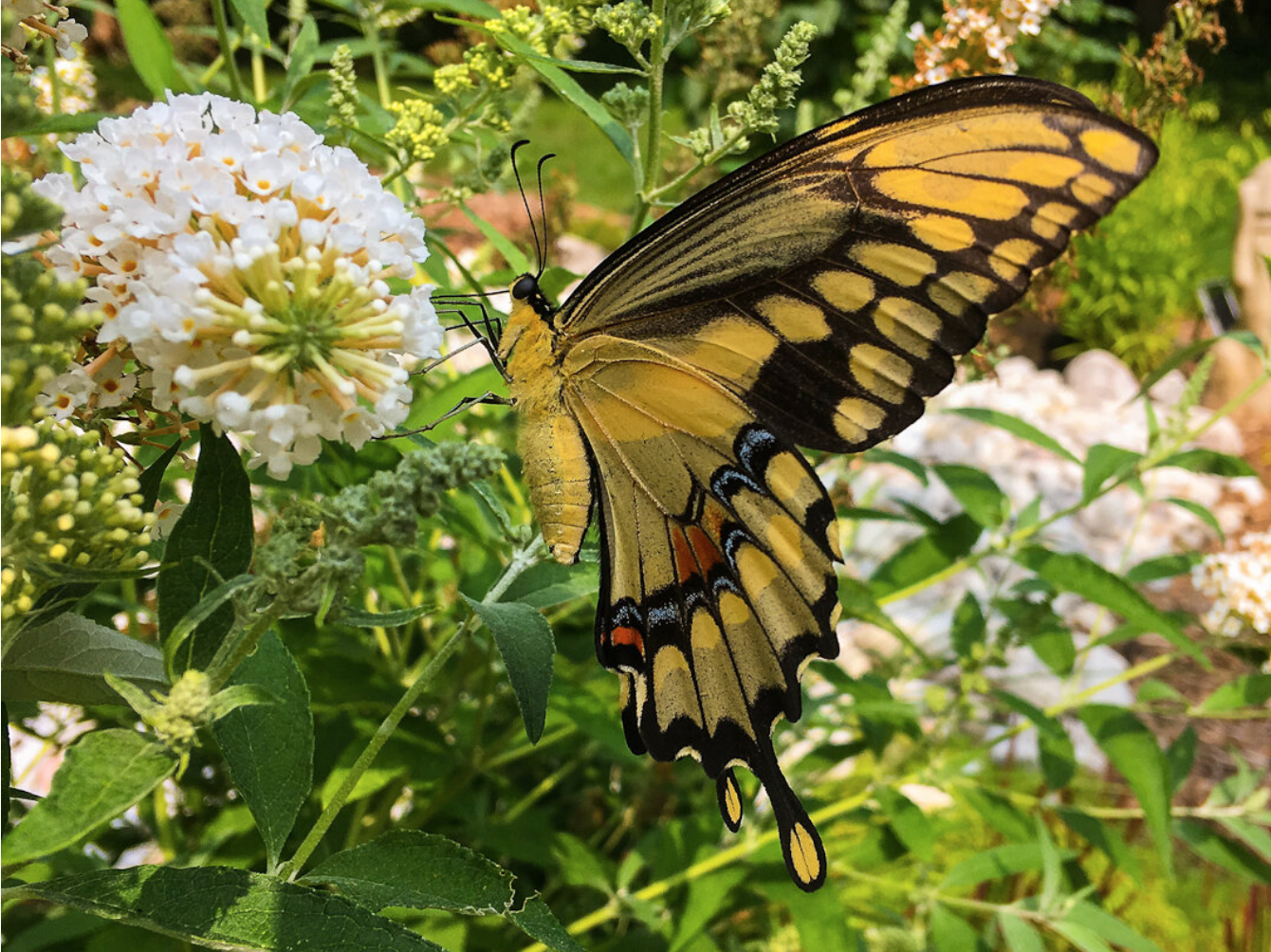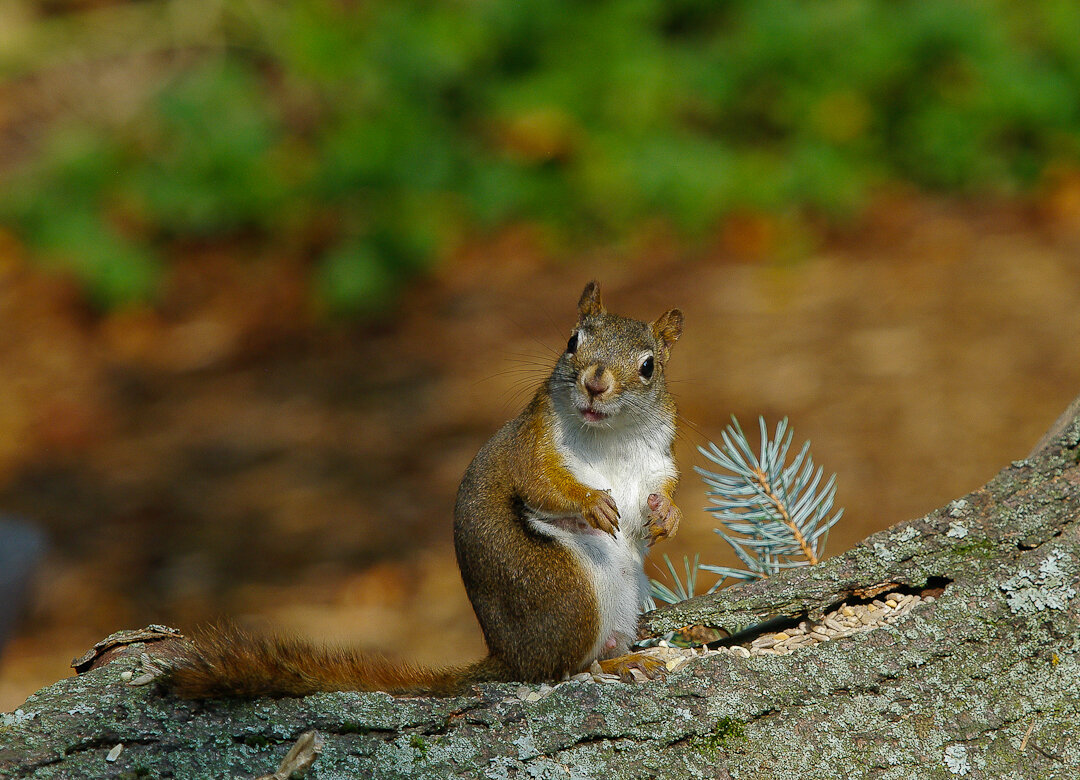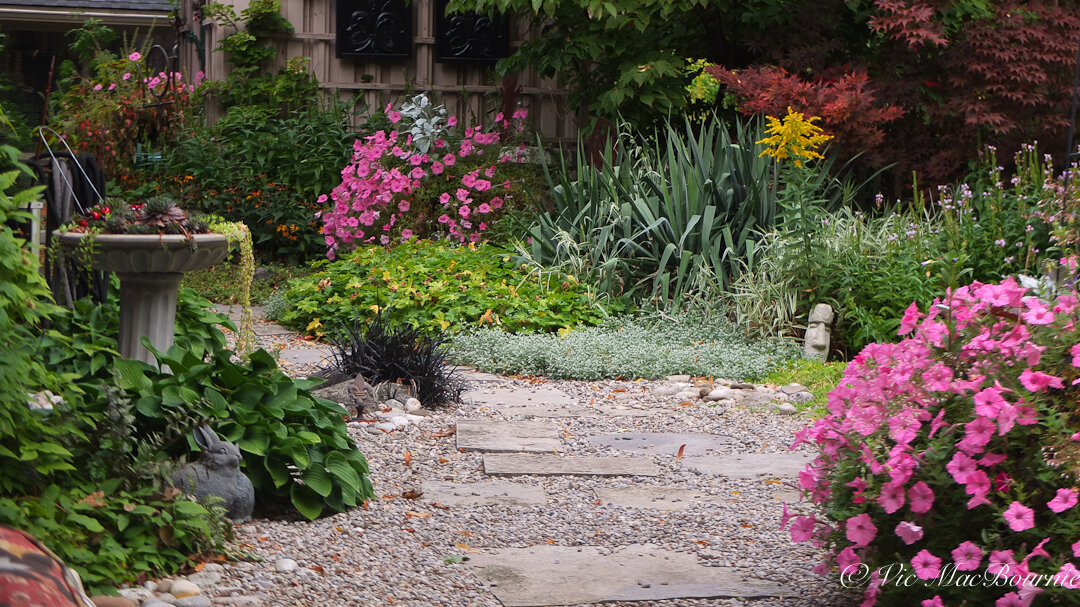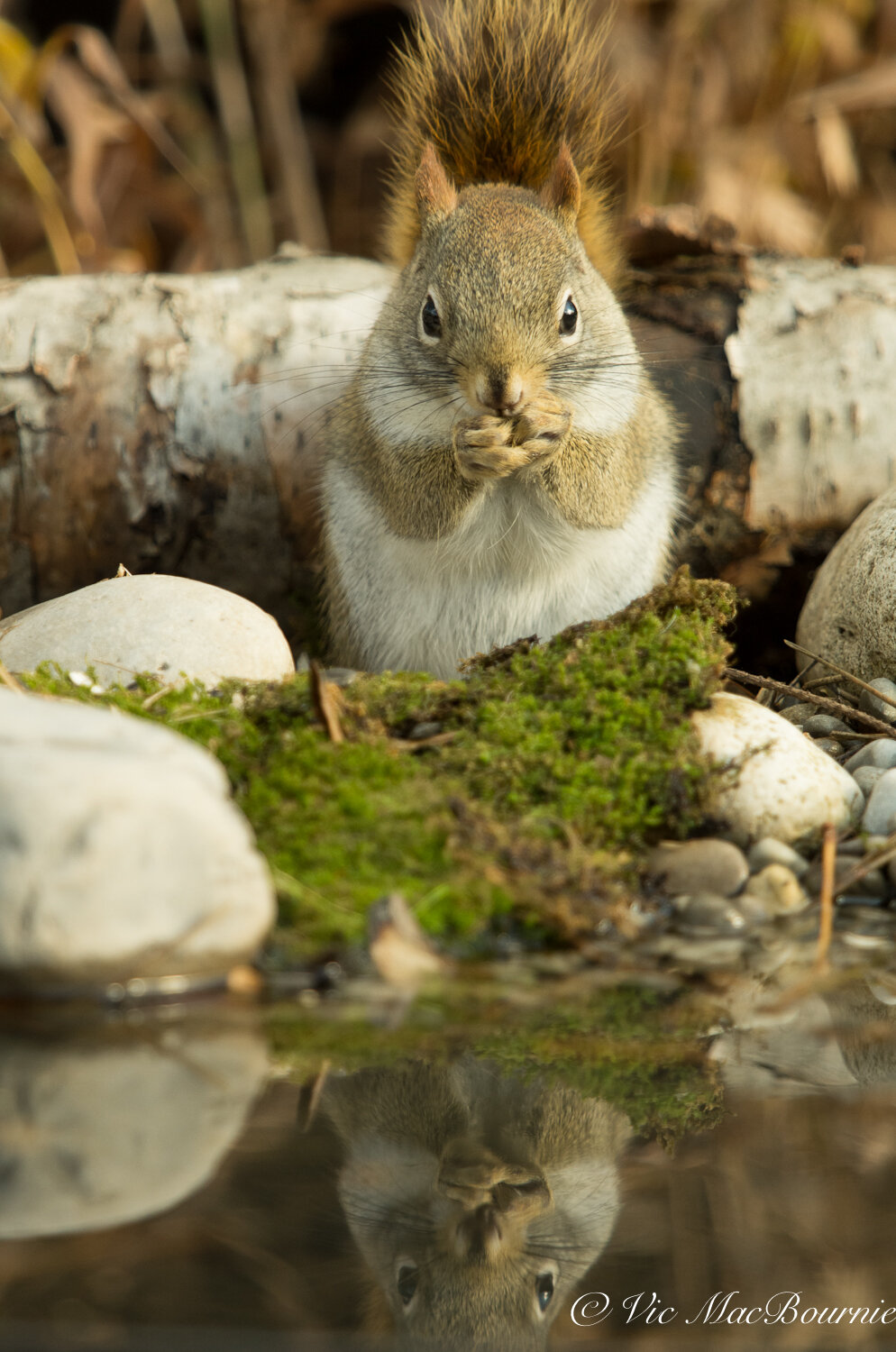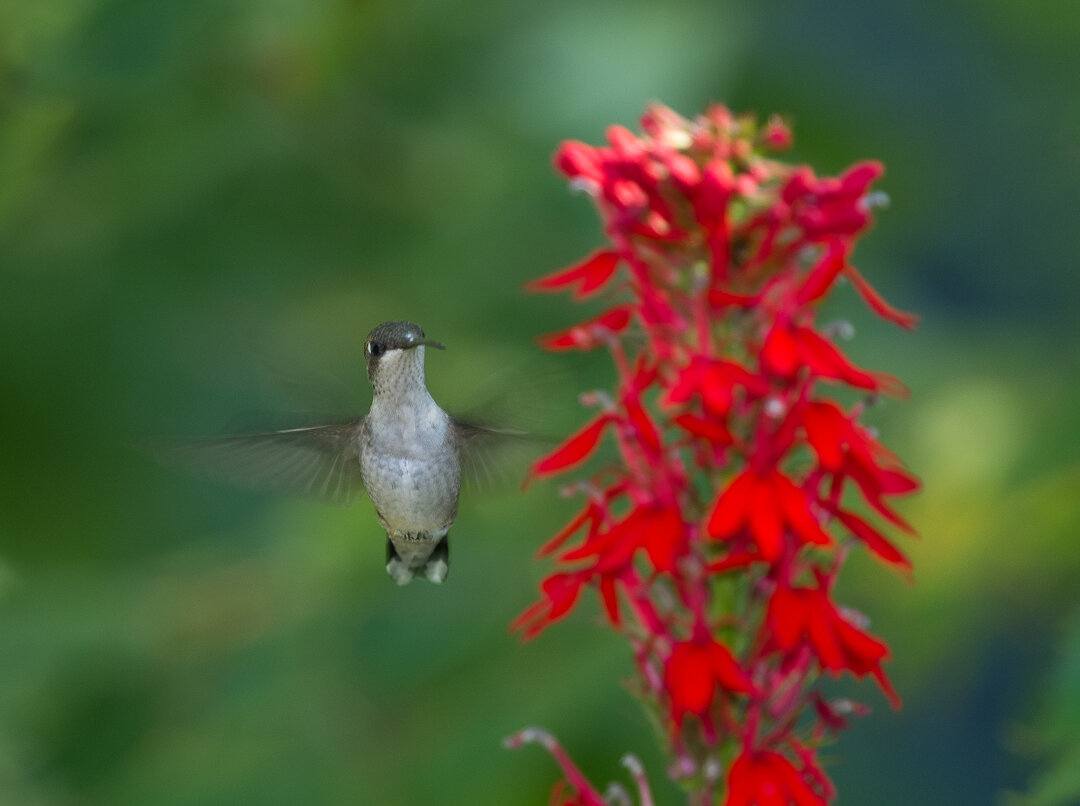Creating a wildlife friendly garden (7 simple steps)
If you have the basis for a woodland garden, you are on your way to creating a wildlife garden in your backyard. The two landscape designs work in harmony but there are specific elements to focus on to create a successful wildlife garden.
Woodland garden provides groundwork for wildlife garden
If you already have the makings of a woodland garden, you also have the groundwork for a wildlife garden.
Woodland and wildlife garden design styles are similar and can work in harmony together, but there are definitely key elements to focus on to create a successful wildlife garden.
I have found that encouraging more insects, reptiles, amphibians, birds and mammals to my garden demands a more detailed focus on the shrub and flower layers of my multi-layered woodland garden.
Generally speaking, in a woodland garden the shrub layer is often as visually pleasing as it is beneficial to wildlife. In a wildlife garden, that approach is reversed and the shrub layer’s primary purpose is to provide food and habitat for a myriad of wildlife. The flower layer also requires a more wildlife-friendly approach.
So how do we get started?
Here are the seven basic principles to create a wildlife garden. (More detailed examination lower in article)
Provide food, water and shelter
Add a variety of plants
Create islands of habitat
Create layers in the garden
Use native plants
Reduce or eliminate pesticides and herbicides
Refrain from any real fall garden cleanup
An impressive example of a giant yellow swallowtail works a butterfly bush in the garden.
Gardeners who are looking to create a successful wildlife habitat need to focus on two primary garden design elements: First, putting an emphasis on providing sources of water (preferably a natural pond), and, two, a focus on creating an edge habitat of native plants that provides both food and a safe habitat for nesting. These two factors together with an already established woodland garden will go a long way to creating a successful wildlife garden.
Habitat loss makes wildlife-friendly garden more critical
The loss of habitat is the most important single factor responsible for the reduction of wildlife numbers in Canada, the United States, Great Britain and elsewhere. The burning issue is: Can we as homeowners take action to reverse this trend in our own yards. The answer, of course, is a resounding yes. Gardeners should also be encouraged to know that creating a wildlife garden can be created and maintained in less time and using less energy than is required in a traditional garden.
Many of us get great pleasure in feeding birds at our backyard feeders, but very few landscape their properties to create a habitat for birds and many other species of wildlife.
As Irish garden designer Mary Reynolds expounds in her book The Garden Awakening, the goal of every gardener is to create an island of native plants that will provide a path for wildlife to travel through our neighbourhoods. She refers to them appropriately as ‘arks’ and is busy creating a movement bringing homeowners around the world together to create arks. (see link at bottom of article)
By using ecological principles in the design of your ark, and incorporating native plant species whenever possible, the wildlife garden will take shape and begin attracting a greater variety of fauna to your garden.
I think Reynolds ark concept can be taken a step farther in a large landscape by creating islands within your ark. Rooms, if you will, that provide more specific food sources and habitat that is particularly suited to that area in your garden. A sunny clearing in the woods, for example, is an opportunity to grow a fruiting shrub and more sun-loving flowers. A wet area provides a different opportunity to create an island to encourage everything from toads and salamanders to dragonflies and other wetland insects and butterflies as well as aquatic loving native plants, everything from native iris to orchids and blueberries.
By using environmentally sound gardening methods, landscaping for wildlife is not only landscaping for the ecosystem, it is also a people-friendly design that family and friends will appreciate and enjoy for years to come.
Begin wildlife-friendly garden with a brush pile
Probably the single most effective step you could take besides eliminating herbicides and pesticides in your garden is to create a brush pile for wildlife. It is such an important resource for wildlife – everything from insects, reptiles, birds and mammals – that creating even a simple, small brush pile will go a long way to kick-start your wildlife garden.
In our garden, we actually have two on the go. One is more of an open pit compost pile that is made up of primarily cuttings from plants and shrubs that gets topped up in spring and fall with spent soil from our many containers. Several branches placed on the pile keeps it open and accessible to small mammals. Some food scraps make it to the pile but it is not a traditional compost. Almost all the soil is left in place on the pile to encourage biodiversity in the pile. I have seen Coopers hawks hunting there on a regular basis as well as fox and snakes.
The second pile is a more traditional woodpile made up of large, medium and small branches, the result of a recent tree trimming. It became the main dumping ground for small amount of fall leaves we collected this year. In a few short months, it has become a favourite spot for a family of red squirrels as well as a number of insect eating birds that patrol the pile on a daily basis for insects, eggs and pupae. For more on the importance of a woodpile, go to the bottom of this story for a link to an earlier story.
Difference between wildlife-friendly and traditional landscaping
Traditional landscaping usually means a carpet of lawn and a collection of decorative, exotic plants. These landscapes are more concerned with visual and esthetic goals, such as choosing hybrid shrubs and flowers more for their form, colour and texture than the benefits they may have for wildlife. Benefits to wildlife, in these instances, are more unintentional than intentional.
These traditional landscapes usually put high demands on the use of water, energy and chemicals to remain healthy. These landscapes are not any more healthy for we humans as they are for the local wildlife species who cannot thrive in these environments.
As Reynolds explains: “I’ve discovered that gardens can become something very special if we approach them differently. If we invite Nature to express her true self in these spaces and then work to heal the land and bring it back into balance, something magical happens. Nature begins to interact with us on an energetic, emotional and physical level.”
A natural garden path with a combination of native perennial and annual flowers and wildflowers creates a welcoming habitat for backyard wildlife.
Ecological guidelines for planning and maintaining a wildlife garden
Reynolds, in her ground breaking gardening book, gores on to say: “If nature is left to its own devices and without imbalances in the ecosystem such as the overpopulation of hungry deer or and infestation of rabbits it will reclaim its territory and become Woodlands once more.”
Those same sentiments were emphasized in another outstanding book, Garden Revolution by authors Larry Weaner and Thomas Christopher. They ask: “if I do nothing, what will happen?” your answer will be “A forest will develop.”
Providing water is critical for wildlife to survive. A small pond allows access for small mammals, birds and amphibians.
Weaner goes on to say that “There are powerful environmental reasons for bringing our gardens into a sounder relationship with nature. I honestly believe that having once sampled an ecologically driven approach, gardeners won’t want to do anything else.”
So, by letting our gardens go and doing very little maintenance, a wildlife garden will emerge. However, with a little help on our end, it can be done a lot quicker by following these seven basic principles.
Seven steps to a successful wildlife garden (explained)
1) Provide the three basic requirements: Namely food, water and shelter. The proper selection of native plants can create a reliable supply of food throughout the seasons. these same plants can provide shelter and nesting ha and bird baths, both raised and on-ground or a small pond can provide water.
2) A variety of Plants: Wildlife come in many different forms. It’s easy to focus on seed-eating birds that we are so familiar with at our bird feeders. But, just as we try to provide a variety of food at our feeders, it is just as important to ensure a diversity of food and cover in our gardens to provide for a greater variety of wildlife.
3) Islands of habitat: Creating clumps of vegetation and habitat is much more valuable than planting individual shrubs and trees spaced widely apart in our lawns. Better shelter is provided by planting shrubs and trees in natural looking clumps, hedgerows and thickets. Open areas of grasses and flowers between these islands creates an attractive habitat for birds and small mammals that can move through the garden from island to island in relative safety.
4) A layered approach: Much like a traditional woodland garden, the wildlife garden benefits from a layering of plants and trees. Unlike a woodland garden that focuses on the general layering of trees, the wildlife garden goes into more detail and looks at the layering of the lower storeys of the woodland garden. Food and cover needs to be offered at a variety of levels. The focus is more on layering at the ground cover and shrub/small tree levels where the majority of wildlife live and feed.
5) The use of native plants: In his book Bringing Nature Home, How you Can Sustain Wildlife with Native Plants, Douglas Tallamy makes a convincing argument for the use and importance of native trees, shrubs and plants in our gardens. He explains that if gardeners continue to “landscape predominantly with alien plants that are toxic to insects…. We may witness extinction on a scale that exceeds” anything ever experienced on this earth.
It’s important to note that our native wildlife evolved in these habitats so they are better adapted to our native plant communities.
Tallamy explains that: “Because life is fuelled by the energy captured by the sun by plants, it will be the plants that we use in our gardens that determine what nature will be like 10, 20, and 50 years from now.”
Take it from Tallamy, native plants are key to creating a working wildlife garden.
Purchasing native plants rather than the hybridized versions often sold at parking lot garden centres or many large nurseries is not always easy. Get to know your plants names (including the latin names) before you go to the nursery so you can be sure to purchase the native varieties. Also there are on-line sources for native seeds and plants that are available in many areas. Just be sure to purchase native plants to your area.
6) Chemical use: We have come a long way in the use of chemicals in our gardens but it continues to be a major problem. Synthetic fertilizers and pesticides may result in lusher greener lawns, but they kill organisms that are vital to the natural processes of pollination and decay. These very organisms, often caterpillars, insects and larvae, are food for many wildlife species, including birds especially when they are feeding their young in spring.
In a wildlife garden, choose to use a natural and ecological approach such as mulching to reduce weeds, planting hardy natives plants and weeding by hand if necessary.
7) Fall cleanup: It is extremely important to wait until spring to do a garden cleanup involving the removal of fall leaves and dead plant material. Even better, wildlife gardeners should leave areas of the garden as a no-maintenance zone to provide cover and food for wintering wildlife. Insect pupae, spider eggs, seeds and berries left over from the fall can be important food sources for spring migrants at a time when there is little other food available to them. Refrain from trimming lower branches of shrubs and evergreen trees to provide a safer refuge for animals from the freezing temperatures and winds of winter.
What can you expect from your wildlife design?
The closer you live to a piece of native habitat, like a woodlot or open meadow, the more wildlife you can expect to visit your property. Also, these wilder areas will attract a greater variety of wildlife as well as animals and birds (primarily carnivores) that exist higher up the food chain. Fox, coyotes, and depending where you live bobcats, bears and cougars, in addition to birds of prey could be regular visitors to your yard if you are fortunate enough to live near large wild areas.
But even if you live in the heart of an urban or suburban area, a well-designed wildlife garden can attract an astonishingly larger variety of birds and animals than one might think. During migration, for example, uncommon birds may “drop down” for a few days to feed on insects or small rodents. Urban foxes, owls and hawks may decide to make it their home or an important part of their daily hunting routines.
How long will it take to get results?
Patience is key. A successful wildlife garden does not happen overnight or even in a single growing season.
That’s not to say you can’t see instant success. The simple act of planting cardinal flowers will encourage hummingbirds in the area to visit your garden. Planting a single serviceberry or chokecherry bush could bring in plenty of fruit-eating birds and other wildlife that were rare or uncommon visitors to the garden prior to the planting.
A more reasonable expectation is to tackle the project as a five-year plan, building on it each and every year as an ever increasing number and variety of wildlife begin to appear on your property.
“I’ve discovered that gardens can become something very special if we approach them differently. If we invite Nature to express her true self in these spaces and then work to heal the land and bring it back into balance, something magical happens. Nature begins to interact with us on an energetic, emotional and physical level.”
Garter snakes are a welcome addition to any woodland wildlife garden.
A personal experience: Where are the snakes?
Let me give you an example from our garden experience. When we first moved in more than 20 years ago, our front and backyards were grass covered dead zones with a few large trees. What little wildlife there was came from the large woodlands that surrounded our neighbourhood. The animals, deer and fox often wandered through the yard but rarely stayed long enough for us to appreciate them in any way.
One thing that really shocked me in those early days was that I could find no snakes on our property. For years, there were no signs of the completely harmless little garter snakes that should have been common in our large rural garden.
But that slowly changed as the property became more naturalized.
By no means are we now overwhelmed with these small snakes, but it is now not uncommon to see a garter snake, especially if you know where to look. Rock piles, leaf litter, large boulders, wood piles and an abundance of prey have encouraged these wonderful snakes to call our property home.
This spring, our neighbours asked me if I had ever seen any snakes on our property, after they saw two strolling down our side pathway together. They were surprised to see them despite being surrounded by hundreds of acres of natural woodland owned by the local conservation area on the Niagara escarpment where snakes are no doubt abundant.
It wasn’t that they disliked the snakes, it was that after more than 20 years of not seeing them, they were surprised to all of a sudden see two.
Our neighbours were also surprised after I told them I was installing owl boxes on my property. They really didn’t know, or had never given it much thought, that owls existed in and around our heavily forested neighbourhood. Despite an abundance of huge trees and surrounded by acres and acres of natural forests, the many years of living with a lack of wildlife in our neighbourhood dead zone of highly chemical-laden lawns and pesticide-covered properties made owls and other predators a rarely observed presence in the area.
Government regulations to herbicide and pesticide use is beginning to change the amount of wildlife in urban and suburban areas, but we still have a long way to go.
I’m happy to report, however, that just recently the same neighbours told us that they had seen an owl in their backyard.
Earlier this summer, I watched a fox sitting on one of the large boulders in our front yard grab a garter snake that was sunning on the rocks. I hope it wasn’t the same one that I saw sunning itself on a rock in the backyard in early spring.
And so, the cycle of life continues to grow twenty-plus years after the wildlife garden began to take root.
I expect it to continue to evolve and to watch the emergence of a greater variety of insects, butterflies, reptiles and mammals slowly appear over time.
Planning your wildlife garden
If you are beginning with a blank slate, planning your landscaping will save you time and money and the final product will be better.
A three-step process beginning with a yard survey will set the groundwork for a detailed preliminary plan.
The preliminary plan should incorporate all seven principles of the wildlife garden introduced earlier in this post.
The final stage is the planting of the garden. This stage can be tackled in a single planting if the garden is small or preferably over the course of several years for a larger property.
Plants, shrubs and trees to consider for your wildlife garden
Consider the following small trees and shrubs
Alternate-leaved Dogwood
American Elder
American Mountain Ash
Chokecherry
Common Juniper
Crabapples
Eastern red cedar
Hawthorn tree
High bush cranberry
Pin cherry
Red mulberry
Serviceberry
Staghorn sumac
White Cedar
Flowers and vines to consider for wildlife garden
• Black-eyed Susan
• Coreopsis
• Evening Primrose
• New England Aster
• Native milkweed
• Spotted Jewel weed
Vines to consider
• Virginia Creeper
• Trumpet Creeper
Large trees to consider planting
Trees, especially evergreens, are central to any wildlife landscape. Evergreens such as Eastern white pine provide year-round cover and produce cones as a food source for small mammals and songbirds.
Deciduous trees provide a wider variety of food types – nuts, berries, and seeds – but are best suited as summer cover and nest sites. These trees also have larger canopies providing more shade and more conducive environments for spring flowers.
As noted in Tallamy’s book Bringing Nature Home, Oaks are especially valuable as a food source for a number of species, such as blue jays, squirrels, chipmunks and woodpeckers as well as insect-eating birds that feed on the many insects and caterillars that depend on oaks as a host tree.
Cherries are an excellent choice for a berry tree. Birches attract small finches, such as redpolls, goldfinches and siskins, to their catkins.
The Eastern red cedar (Juniperus virginiana) is one of the best evergreens to provide cover and nest sites for songbirds. The gin-flavoured berries are a favourite food of cedar waxwings.
Consider the following Evergreen trees
• Red Pine
• Eastern white pine
• white cedar
• Balsam fir
• White spruce
• Eastern hemlock
Consider the following large Deciduous trees
• Oaks
• Maples
• White birch
• White ash
• Butternut
• Shagbark hickory
• Black cherry
• Hackberry
The importance of shrubs in the wildlife garden
Unlike a woodland garden, shrubs are the stars of the wildlife garden. They can provide denser cover, reach maturity faster and provide resources for wildlife that live closer to the ground. Many of the berry-poducing shrubs are important food sources for spring and fall migrant birds.
The American yew and common juniper are excellent native evergreen shrubs for wildlife.
There is a much wider variety of native deciduous shrubs to consider, including red-osier, gray and alternate-leaved dogwoods. Honeysuckles provide good shelter for birds and nectar for hummingbirds. Rosa rugosa is a good choice to include in plant islands in the garden.
A ruby-throated hummingbird eyes a native cardinal flower as a source of nectar.
Plants for hummingbirds
Don’t forget to provide plants for hummingbirds. These entertaining little birds can be attracted in very urban areas if they are provided with the proper habitat. Red flowers are the most enticing but they are also attracted to orange and yellow flowers. Consider planting coral bells, hollyhock, columbine, morning glory, larkspur, scarlet sage, spotted jewelweed, wild bergamot and scarlet bee balm.
Plants for butterflies
Plant purple, blue, yellow and pink flowers to attract butterflies. Try to use species (non cultivated) plants to attract butterflies because nectar production and fragrance are often sacrificed to obtain showier plants.
Most of these plants will also attract bees to your garden.
Consider planting asters, goldenrods, thistles, dogbane, zinnia, lupines, bergamots, black-eyed susans, coneflowers, coreopsis, daisies, phlox, verbena, yarrow and milkweeds. If you want to encourage black swallowtail butterflies, plant dill, parsley or Queen Anne’s lace.
Important links related to this story:
We are the Ark - Chelsea Gold medal winner and Irish Garden designer Mary Reynolds’ site aimed at uniting gardeners around the world to build natural islands of native plantings. Link here.
More links from this website
Building a woodpile - This is a link to an earlier post on the importance of building a wood or brush pile.
Helping birds and other wildlife in our gardens. This post zeroes in on what we can do to help our garden visitors. Go to the post here.
How to help birds survive winter. Go to post here.
Tips for using water to attract birds. Go to post here.
Attract birds in winter with DIY heated birdbath. Go to post here.
Bringing Nature Home book review. Go to earlier post here
This page contains affiliate links. If you purchase a product through one of them, I will receive a commission (at no additional cost to you) I try to only endorse products I have either used, have complete confidence in, or have experience with the manufacturer.

